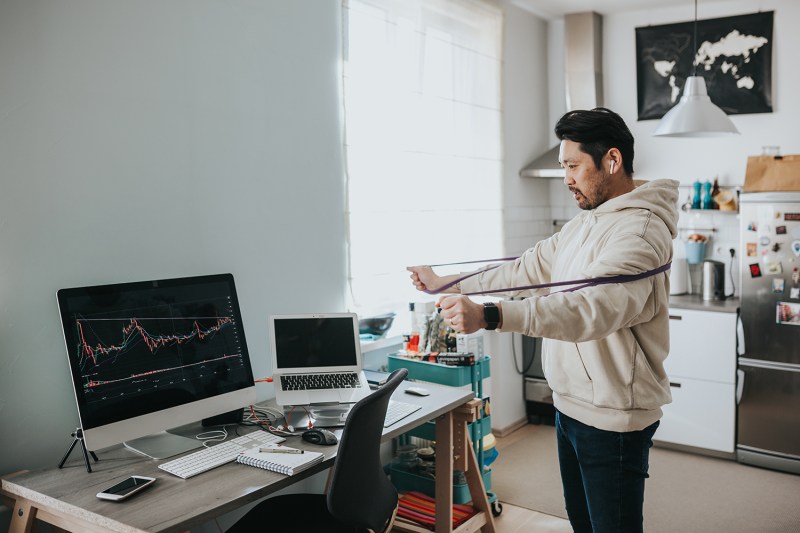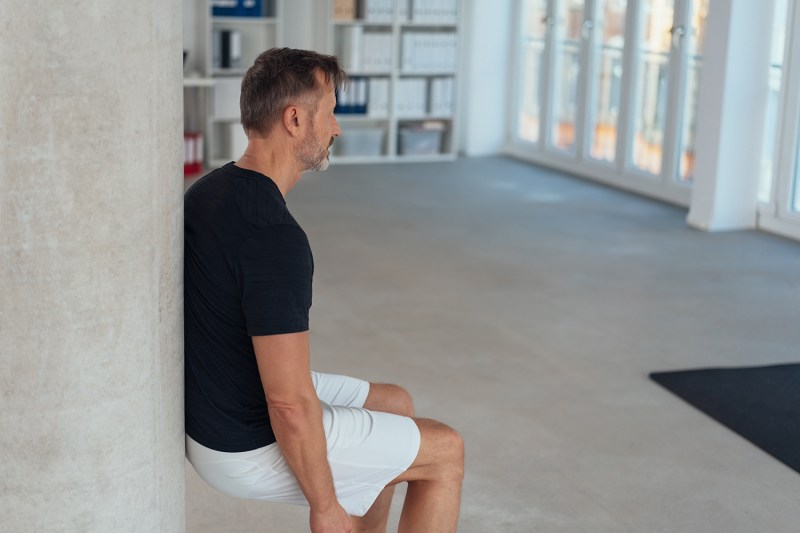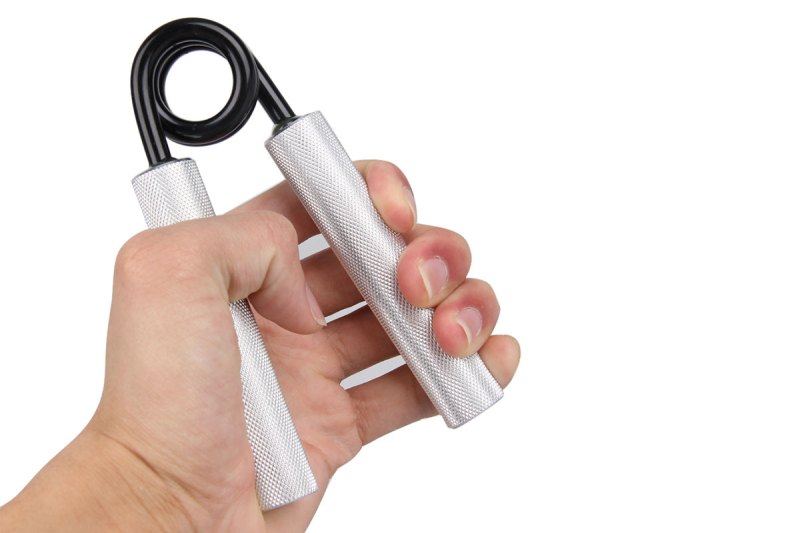
If you’ve been working from home this past year, you’ve likely noticed that the lines between your personal and your work life tend to get a bit blurry. You can roll out of bed and into a Zoom meeting in five minutes flat, you can do laundry in between client presentations, and your workspace also becomes your working out space. Even if you’re short on time and can’t spend an hour on the exercise bike you purchased mid-pandemic, there are still a couple of exercises you can do from your desk at home so you can tone your muscles and get the blood pumping before that companywide call. In fact, you can tone that core, sculpt your arms, and strengthen those legs without ever leaving your Slack channel. You just have to rethink the way you use your space, and that includes making the most of that chair and even the very walls around you.
To help you get the most of your deskside workout, we spoke to Nathaniel Oliver of Type A Training, an in-home, outdoor, and virtual personal training service based in New York City. In our conversation, he stresses how this new working culture can have potentially damaging impacts on our bodies. Below, Oliver outlines a few exercises that can help alleviate some of the stress working from home places on your upper body and tone your muscles at the time.
Warmup

Before pulling out those dumbbells from storage and cranking out some reps, it’s important to get your body moving with a warmup. A quick 10- or 20-minute walk or jog around the block helps loosen up your muscles after you’ve been sitting for a long period of time. If you don’t have time to take a walk outside, Oliver suggests a few stretches to get the blood circulating a bit more.
- Wall Stretch
Place your hand on the wall, elbow slightly bent or straight, turn your body away from the wall. Repeat on the opposite side. Hold each stretch for 15 to 30 seconds or three to five breath cycles (one inhale and exhale). - Walkout into Cobra
With this stretch, the goal is to reverse all the rounding and poor posture you might have from sitting at your desk all day. Start by slowly bending forward, keeping your lower back flat, and at the same time, focusing on the stretch in your hamstrings as you walk out into a push-up position. Once you are in a push-up position, lower your hips to the floor and lift your chin up towards the ceiling and stretch your abdominal muscles. Hold for a few breath cycles and do the same exercise in reverse. - Head Stretch
If you suffer from tech neck, this one is for you. Simply place your hand on the left side of your head and gently pull to the right. Hold for 8 to 10 seconds Repeat on the opposite side, moving your head straight down and back to stretch all angles. - Knee Highs
If you can’t go for a run outside, get your heart rate up by running in place and lifting your knees as high as you can. Bend your arms at the waist and tap your palms to the tops of your knees to ensure correct form. Do three sets of 20 repetitions, or until you’re out of breath.
Leg exercises

The legs are the biggest muscle group in the body so targeting them in your workouts will give you a better ROI in terms of effort and results than, say, your arms. If you want to take a break from spreadsheets and get your quads burning, try these five exercises that you can do from your desk.
- Chair Squat
Pretty simple stuff: stand up from your chair, and then lower yourself again (no hands!) until your thighs brush the seat. Straighten up. Repeat until it burns. - Calf Lift
Also simple. Stand up. Now lift yourself up onto your tiptoes, then back down, then up, then down. Stand on one leg while doing these lifts to go into beast mode. - Wall Sit
“Wall sits are a great exercise to help activate the core as well as get the legs moving from all that sitting,” Oliver said. Yes, these are miserable. But they are also highly effective at building quads. Rest your back against the wall with your legs bent to a 90-degree angle. Keep your shoulders brushing the wall, and hands off your knees. Much pain. Much gain. - Pistol Squat
This is perhaps the toughest squat variation one could do, which makes it incredibly effective if you’re low on time, space, and energy. Start by standing on one leg with your other leg stretched out in front of you and drop into a deep squat, pointing the raised leg out straight out. This exercise targets quads, hamstrings, and glutes with exacting precision. Repeat five times on each leg, as many reps as you can stand. - Lunges
Lunges are a classic for a reason — they’re incredibly effective at targeting all the important muscles in your legs. Get in a lunge position and slowly bend the knee of your front leg forming a 90-degree angle without extending your knee past your toes. Kiss your back knee to the ground and come up. Repeat 30 times, switching legs. Good form is crucial here, according to Oliver. “The biggest mistake I see people doing is extending their knees beyond the ankles when they are parallel to the floor,” he said. “If the knees extend past the ankles, you’ll be utilizing your calves instead of your quads, but it also adds stress to the knees.”
Arm exercises

If you have a set of dumbbells at home, it’s a good idea to keep those weights near your desk, so you can whip out a few sets of bicep curls in between calls. But for a few more subtle ways to get in an arm workout at work, try these techniques.
- Grip Strength Trainer
Invest the $15 or so in a decent grip training tool and you can squeeze away all day, fighting through stress and building a stronger grasp and mighty forearms. - Water Bottle Deltoid Lift
Hold a full water bottle straight out to the side of your torso parallel to the ground and move your hand around in small, rapid circles. Seem easy? Do it for a minute without stopping. Now two. Also, try holding your arm out in front of your body and doing the same. - Chair Dips
Chair dips are a quick and effective upper body exercise that anyone can do. Simply slide to the edge of your seat and grip the front or side of the chair (make sure it’s stable) and bend your knees so they’re parallel to the floor. This exercise can be easily modified for beginners or fitness experts to get the most out of the movement. “If you are a beginner, do quarter reps, or if that is too easy, proceed to bend the arms all the way to 90 degrees,” Oliver said. “If you want to go to another level, you can straighten your legs out or find another chair or even your desk and place your feet on there. If you do decide to elevate your feet make sure you get them almost straight and locked in position, which will make you more stable while doing the exercise.”
Core training

A solid core is important if you want to tone up all other areas of your body, so don’t neglect to exercise yours. And don’t forget to file those expense reports, either. Hey, you can do both at the same time! Here are a few ways.
- Seated Plank
Sit near the edge of your chair, and now lean back about 30 degrees, keeping your torso straight. Feel that tension in your lower back and abs? Feel the burn for 30 to 60 seconds and repeat. - Standing Cross Crunch
Turn off the video on your Zoom call and tune up your six-pack with this move. Stand up at your desk and place your hands behind your head, interlocking your fingers. While engaging your core, raise your left knee and touch it with your right elbow, then raise your right knee and touch it with your left elbow. Do three sets of 10. - Knee Lifts
Slide toward the end of the chair, lightly stabilize yourself with your hands, and lift your knees up toward your chest. You can do one leg at a time if need be, but lifting both simultaneously is a better workout. - Seated Bicycle Pedal
Save thousands on an indoor exercise bike with this one move. Scoot to the edge of your seat on your chair, supporting your upper body on the armrests. Pretend you’re riding a bike, bringing your knees to your chest one after the other, and contracting your abdominal muscles while you do it. Concentrate on “pedaling” in smooth, consistent circles. Keep your back straight and tuck in your tailbone to prevent arching. This might feel silly at first, but if you keep proper form, it’ll really engage your core.



